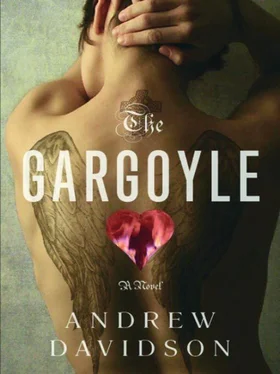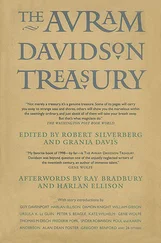I expected that the interior would be all velvet tapestries and thrones, but there were vast expanses of emptiness. Square wooden pillars held up the roof, and the floor consisted of wide planks. She placed her jacket on an iron coatrack just inside the door and said, noticing my interest in the wood, “The beams are cedar and the rafters are fir.”
She started my tour of the house in the living room, which was painted bright red. There was a great fireplace with an interlaced pattern of angels and demons around its stony mouth. There were two armchairs, with a grand rug between, which looked as if they were awaiting regents to sit in them and have serious conversations.
The dining room had large paintings on the walls, mostly intense splashes of color across flowing shapes. They were more abstract than I’d expected; if someone had asked me to guess, I would have said that she’d have paintings with religious themes. But not so. There was an expansive oak table with a fresh display of purple flowers at the center, and candles in iron holders on either side. “Francesco made those. When you see metalwork in this house, you can assume that he did it.” I nodded my head: Sure, why not? Aren’t most homes furnished by Italian ghosts?
In the kitchen were a fat silver stove, an ancient refrigerator, and rows of copper pots hanging from the ceiling. Glass jars with pastas and spices lined the shelves, and sunflower-yellow paint kept the room relentlessly upbeat. Everything was in its place, and the only sign of disarray was an overflowing ashtray. Her house once again surprised me: not the ashtray, but the order.
Her study was dominated by a large wooden desk, which she claimed had once belonged to a king of Spain. I just nodded again: Sure, why not? Italian ghosts can’t do everything. Behind the desk was a very sturdy chair, and to its right side was a leather couch that looked as if it were waiting for one of Dr. Freud’s patients.
Bookshelves, heavy with serious volumes, lined three of the walls. Spenser, Milton, Donne, Blake, and the Venerable Bede represented the English. The German authors included Hartmann von Aue, Wolfram von Eschenbach, Ulrich von Tьrheim, Walther von der Vogelweide, and Patrick Sьskind. Russian books included The Life of Archpriest Avvakum, Mikhail Lermontov’s Demon , and Dead Souls by Nikolai Gogol. Spain supplied the masterpieces of St. Teresa of Бvila: The Interior Castle and The Way of Perfection. The Greeks were not going to allow themselves to be forgotten: Homer, Plato, Aristotle, Euripides, and Sophocles took up most of the bottom shelf, as if they had long ago decided that bookshelves would be incomplete without everyone else standing on their shoulders. There was a half-wall of Latin volumes, but the only ones that caught my eye were Cicero’s Dream of Scipio and Ovid’s Metamorphoses. Looking a little out of place, but not wanting to be left off the world stage, were a number of books from Asia. I couldn’t tell the Chinese characters from the Japanese, and often even the translated English title couldn’t give the book’s homeland away. Finally, there were copies of all the major religious texts: the Bible, the Talmud, the Qur’an, the four Vedas, and so on.
The most striking thing about the collection was that there were two copies, side by side, of every foreign book: the original, and an English translation. Naturally, I asked Marianne Engel about this.
“The English versions are for you,” she said. “That way we can talk about them.”
“And the originals?”
“Why would I read translations?”
Marianne Engel reached among the books to withdraw two that were not professionally published, but handwritten on thick paper and bound with uneven stitching. The penmanship was her own and the text was, thankfully, in English rather than German. Christina Ebner’s Revelations and The Gnaden-vita of Friedrich Sunder.
“I thought you might want to read these,” she said, “so I translated them.”
There was another item of interest on the bookshelf: a small stone angel whose wings reached heavenward. I inquired whether she had carved it but my question, so innocently asked, seemed to hurt her. She blinked a few times, as if trying to keep herself from crying, and puckered her mouth in an effort to calm her quivering lower lip. “You carved that for me,” she said with a cracking voice. “It was my Morgengabe. ”
That concluded the tour of the main floor. Her workshop was in the basement, but I didn’t have the legs to go down. My first day out of the hospital had been long enough and, in truth, the freedom was overwhelming. I’d grown accustomed to knowing every inch of my surroundings and every minute of my schedule, but now I was confronted with endless new sensations. We passed the remainder of the afternoon sitting in the living room, talking, but she couldn’t seem to put back on her face the smile that had been wiped away by my question about the stone angel.
THIS WON’T LAST, YOU KNOW.The snake swished its tail around my intestines. YOU WILL CRUSH HER UNDER YOUR INSENSITIVITY.
In the early evening, I climbed the stairs to the upper floor with Marianne Engel walking behind to make sure I didn’t tumble. I was aching for a needle of morphine that would shut up the bitchsnake. I had a choice of two rooms: one was the visitor’s room, already made up, the other an atticlike recess that overlooked the graveyard behind St. Romanus. Marianne Engel was concerned that the odd shape of the room, wedged as it was in the corner of the roof, might be too oppressive after months in the hospital, but I instantly took a liking to it. “It’s like a belfry. It’s perfect.”
She fixed me with morphine that was sweeter than the desert’s first rainfall, and the snake slithered silently into her hole. I assumed I would sleep through until the next morning, but it didn’t work out that way. It was February and not yet warm outside, but for some reason it seemed ridiculously hot inside. Perhaps the effect was partially psychological, from the stress of sleeping in a new place for the first time in ten months.
My unbreathing skin revolted in the feverish night and I dreamed of concentration camps, of human ovens, of people with matchstick bodies. Their hunger was transforming them into something too thin to be human. Their eyes bulged and accused; they were hunting me with their stares. Someone said in German, “Alles brennt, wenn die Flamme nur heiЯ genug ist. Die Welt ist nichts als ein Schmelztiegel.” Everything burns if the flame is hot enough. The world is nothing but a crucible. It was the same phrase I’d heard in my hospital nightmare about the skeleton bed going up in a shrouded flame.
I awoke suddenly upright in my thin sheets, wishing I could sweat. I heard the snake chanting the word HOLOCAUST. HOLOCAUST. HOLOCAUST. HOLOCAUST.The word, I am told, literally means “burning everything.” The belfry was cooking me; Dr. Edwards had been correct, we needed air conditioning. I AM COMING AND THERE IS NOTHING YOU CAN DO ABOUT IT.There could be no denying that the snake was persistent; it was like having a Jehovah’s Witness living in my spine. I AM COMING AND THERE IS NOTHING YOU CAN DO ABOUT IT.
I looked at Friedrich Sunder’s Gnaden-vita (which means “Mercy-life”) on my bedside table. I decided that I didn’t have it in me to do any reading, especially not something that challenging. I got up on uncooperative legs and, with a little persuasion, was able to point them in the direction of the master bedroom, from which-to my surprise-Marianne Engel was absent. I listened to the house. From below, I heard faint strains of classical music that I didn’t recognize but that, for some reason, made me think about field workers. I struggled down both flights of stairs, from belfry to main floor, then from main floor to basement workshop.
Читать дальше











